Health Care Procedure and Determinants of Health: Māori Population
VerifiedAdded on 2022/11/17
|11
|3189
|494
Report
AI Summary
This report provides an overview of the health care procedures and determinants of health within the Māori population of New Zealand. It highlights key health indicators, including life expectancy, obesity rates, smoking and drinking habits, and mortality rates, comparing them to the non-Māori population. The report delves into the social determinants of health, such as socio-economic factors, ethnic discrimination, and their impact on healthcare access, specifically focusing on access to GPs and dental care. It examines government strategies and healthcare costs, including the impact of health care costs on the Māori community. The analysis includes the effects of racism and discrimination within the healthcare system and their effects on health outcomes. The report emphasizes the need for improved health equity, government subsidies, health literacy, and culturally sensitive healthcare approaches to address the health disparities experienced by the Māori people.
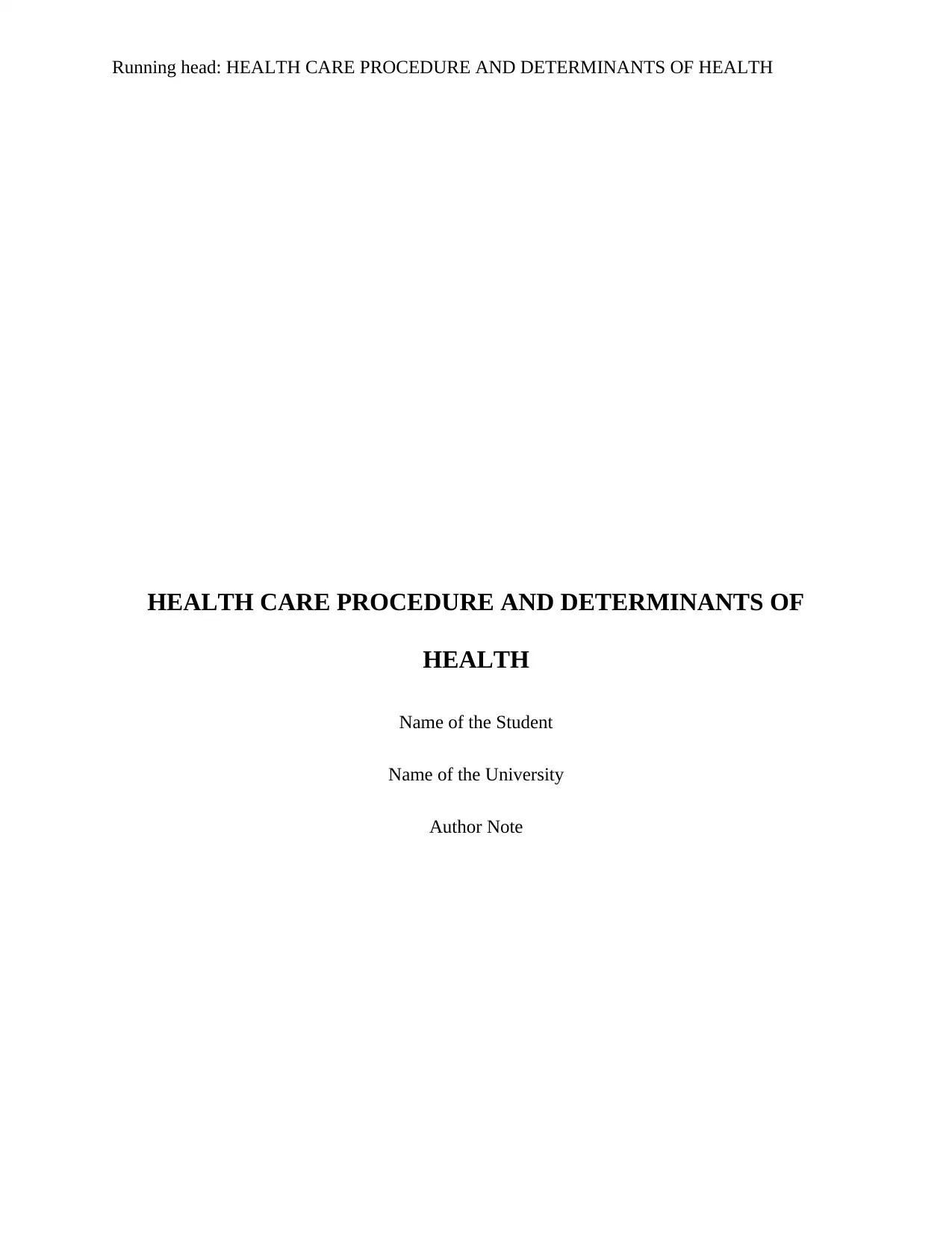
Running head: HEALTH CARE PROCEDURE AND DETERMINANTS OF HEALTH
HEALTH CARE PROCEDURE AND DETERMINANTS OF
HEALTH
Name of the Student
Name of the University
Author Note
HEALTH CARE PROCEDURE AND DETERMINANTS OF
HEALTH
Name of the Student
Name of the University
Author Note
Paraphrase This Document
Need a fresh take? Get an instant paraphrase of this document with our AI Paraphraser
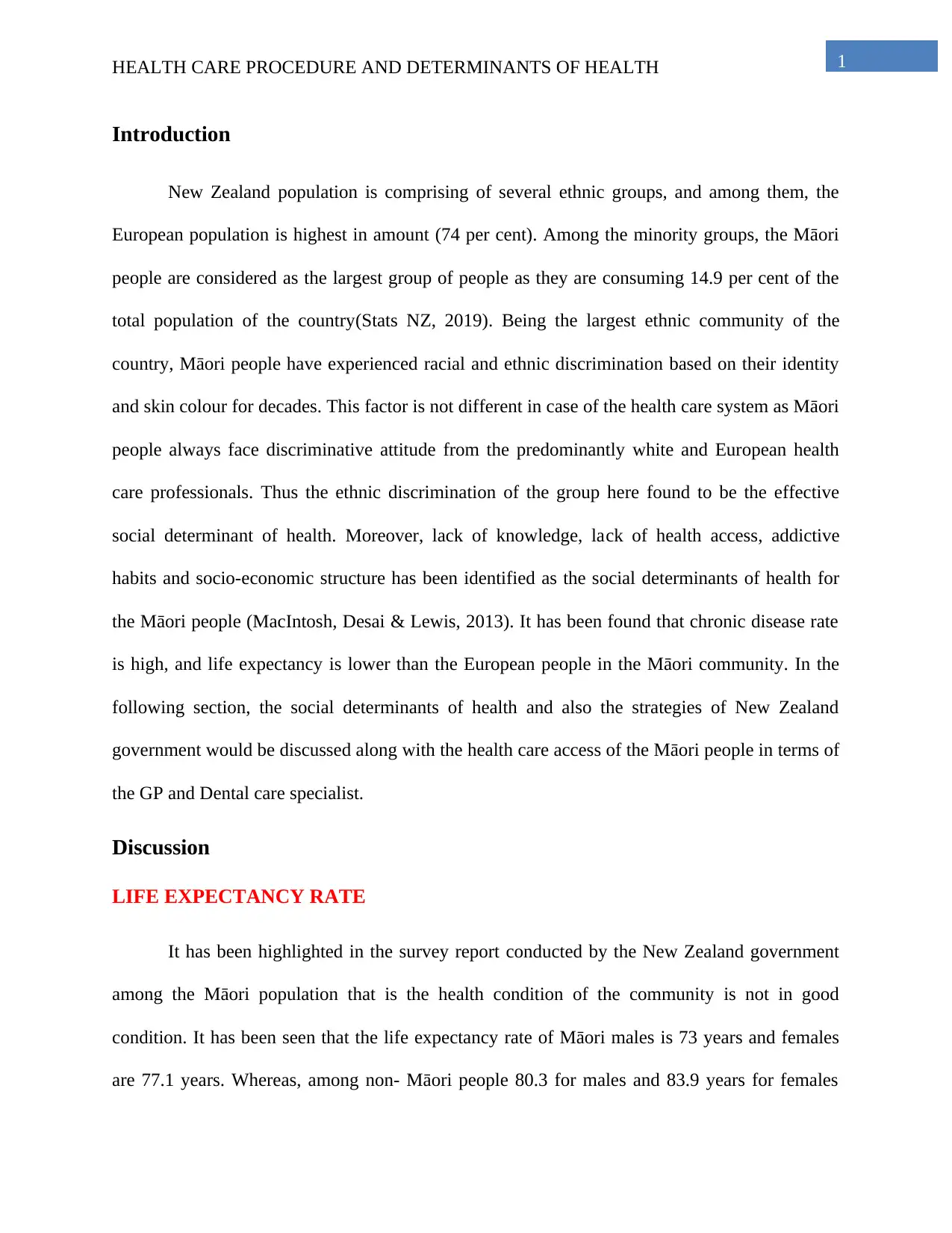
1HEALTH CARE PROCEDURE AND DETERMINANTS OF HEALTH
Introduction
New Zealand population is comprising of several ethnic groups, and among them, the
European population is highest in amount (74 per cent). Among the minority groups, the Māori
people are considered as the largest group of people as they are consuming 14.9 per cent of the
total population of the country(Stats NZ, 2019). Being the largest ethnic community of the
country, Māori people have experienced racial and ethnic discrimination based on their identity
and skin colour for decades. This factor is not different in case of the health care system as Māori
people always face discriminative attitude from the predominantly white and European health
care professionals. Thus the ethnic discrimination of the group here found to be the effective
social determinant of health. Moreover, lack of knowledge, lack of health access, addictive
habits and socio-economic structure has been identified as the social determinants of health for
the Māori people (MacIntosh, Desai & Lewis, 2013). It has been found that chronic disease rate
is high, and life expectancy is lower than the European people in the Māori community. In the
following section, the social determinants of health and also the strategies of New Zealand
government would be discussed along with the health care access of the Māori people in terms of
the GP and Dental care specialist.
Discussion
LIFE EXPECTANCY RATE
It has been highlighted in the survey report conducted by the New Zealand government
among the Māori population that is the health condition of the community is not in good
condition. It has been seen that the life expectancy rate of Māori males is 73 years and females
are 77.1 years. Whereas, among non- Māori people 80.3 for males and 83.9 years for females
Introduction
New Zealand population is comprising of several ethnic groups, and among them, the
European population is highest in amount (74 per cent). Among the minority groups, the Māori
people are considered as the largest group of people as they are consuming 14.9 per cent of the
total population of the country(Stats NZ, 2019). Being the largest ethnic community of the
country, Māori people have experienced racial and ethnic discrimination based on their identity
and skin colour for decades. This factor is not different in case of the health care system as Māori
people always face discriminative attitude from the predominantly white and European health
care professionals. Thus the ethnic discrimination of the group here found to be the effective
social determinant of health. Moreover, lack of knowledge, lack of health access, addictive
habits and socio-economic structure has been identified as the social determinants of health for
the Māori people (MacIntosh, Desai & Lewis, 2013). It has been found that chronic disease rate
is high, and life expectancy is lower than the European people in the Māori community. In the
following section, the social determinants of health and also the strategies of New Zealand
government would be discussed along with the health care access of the Māori people in terms of
the GP and Dental care specialist.
Discussion
LIFE EXPECTANCY RATE
It has been highlighted in the survey report conducted by the New Zealand government
among the Māori population that is the health condition of the community is not in good
condition. It has been seen that the life expectancy rate of Māori males is 73 years and females
are 77.1 years. Whereas, among non- Māori people 80.3 for males and 83.9 years for females
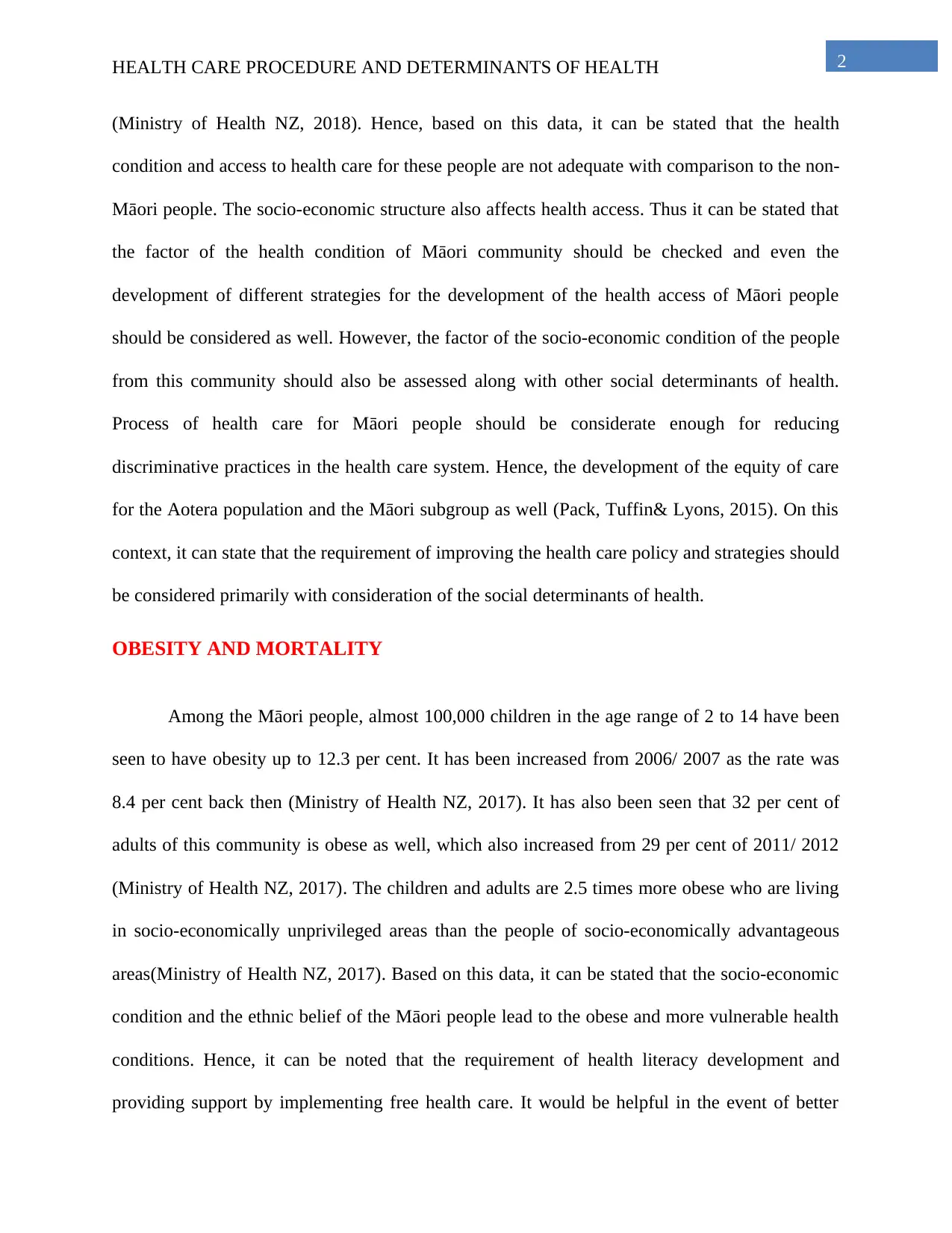
2HEALTH CARE PROCEDURE AND DETERMINANTS OF HEALTH
(Ministry of Health NZ, 2018). Hence, based on this data, it can be stated that the health
condition and access to health care for these people are not adequate with comparison to the non-
Māori people. The socio-economic structure also affects health access. Thus it can be stated that
the factor of the health condition of Māori community should be checked and even the
development of different strategies for the development of the health access of Māori people
should be considered as well. However, the factor of the socio-economic condition of the people
from this community should also be assessed along with other social determinants of health.
Process of health care for Māori people should be considerate enough for reducing
discriminative practices in the health care system. Hence, the development of the equity of care
for the Aotera population and the Māori subgroup as well (Pack, Tuffin& Lyons, 2015). On this
context, it can state that the requirement of improving the health care policy and strategies should
be considered primarily with consideration of the social determinants of health.
OBESITY AND MORTALITY
Among the Māori people, almost 100,000 children in the age range of 2 to 14 have been
seen to have obesity up to 12.3 per cent. It has been increased from 2006/ 2007 as the rate was
8.4 per cent back then (Ministry of Health NZ, 2017). It has also been seen that 32 per cent of
adults of this community is obese as well, which also increased from 29 per cent of 2011/ 2012
(Ministry of Health NZ, 2017). The children and adults are 2.5 times more obese who are living
in socio-economically unprivileged areas than the people of socio-economically advantageous
areas(Ministry of Health NZ, 2017). Based on this data, it can be stated that the socio-economic
condition and the ethnic belief of the Māori people lead to the obese and more vulnerable health
conditions. Hence, it can be noted that the requirement of health literacy development and
providing support by implementing free health care. It would be helpful in the event of better
(Ministry of Health NZ, 2018). Hence, based on this data, it can be stated that the health
condition and access to health care for these people are not adequate with comparison to the non-
Māori people. The socio-economic structure also affects health access. Thus it can be stated that
the factor of the health condition of Māori community should be checked and even the
development of different strategies for the development of the health access of Māori people
should be considered as well. However, the factor of the socio-economic condition of the people
from this community should also be assessed along with other social determinants of health.
Process of health care for Māori people should be considerate enough for reducing
discriminative practices in the health care system. Hence, the development of the equity of care
for the Aotera population and the Māori subgroup as well (Pack, Tuffin& Lyons, 2015). On this
context, it can state that the requirement of improving the health care policy and strategies should
be considered primarily with consideration of the social determinants of health.
OBESITY AND MORTALITY
Among the Māori people, almost 100,000 children in the age range of 2 to 14 have been
seen to have obesity up to 12.3 per cent. It has been increased from 2006/ 2007 as the rate was
8.4 per cent back then (Ministry of Health NZ, 2017). It has also been seen that 32 per cent of
adults of this community is obese as well, which also increased from 29 per cent of 2011/ 2012
(Ministry of Health NZ, 2017). The children and adults are 2.5 times more obese who are living
in socio-economically unprivileged areas than the people of socio-economically advantageous
areas(Ministry of Health NZ, 2017). Based on this data, it can be stated that the socio-economic
condition and the ethnic belief of the Māori people lead to the obese and more vulnerable health
conditions. Hence, it can be noted that the requirement of health literacy development and
providing support by implementing free health care. It would be helpful in the event of better
⊘ This is a preview!⊘
Do you want full access?
Subscribe today to unlock all pages.

Trusted by 1+ million students worldwide
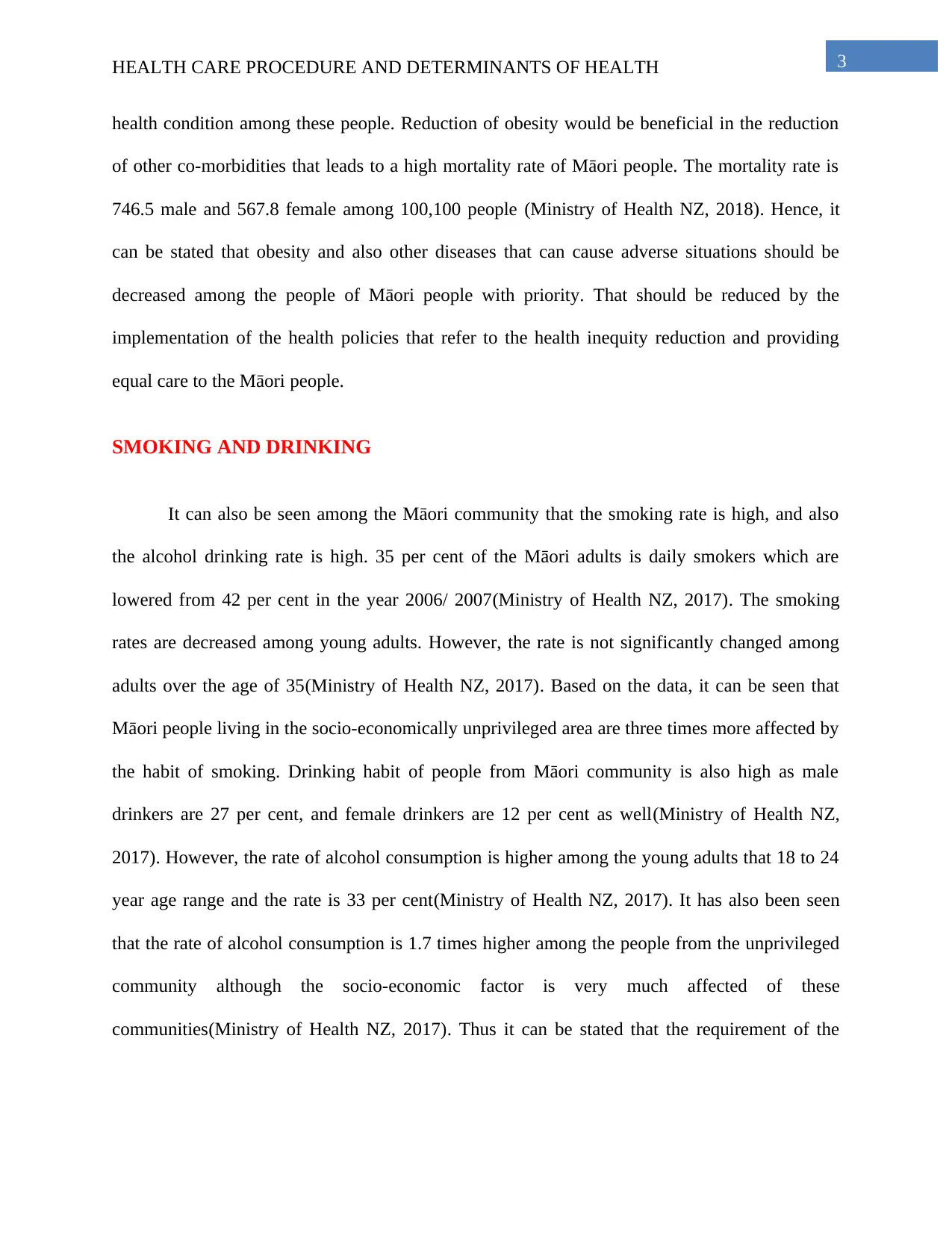
3HEALTH CARE PROCEDURE AND DETERMINANTS OF HEALTH
health condition among these people. Reduction of obesity would be beneficial in the reduction
of other co-morbidities that leads to a high mortality rate of Māori people. The mortality rate is
746.5 male and 567.8 female among 100,100 people (Ministry of Health NZ, 2018). Hence, it
can be stated that obesity and also other diseases that can cause adverse situations should be
decreased among the people of Māori people with priority. That should be reduced by the
implementation of the health policies that refer to the health inequity reduction and providing
equal care to the Māori people.
SMOKING AND DRINKING
It can also be seen among the Māori community that the smoking rate is high, and also
the alcohol drinking rate is high. 35 per cent of the Māori adults is daily smokers which are
lowered from 42 per cent in the year 2006/ 2007(Ministry of Health NZ, 2017). The smoking
rates are decreased among young adults. However, the rate is not significantly changed among
adults over the age of 35(Ministry of Health NZ, 2017). Based on the data, it can be seen that
Māori people living in the socio-economically unprivileged area are three times more affected by
the habit of smoking. Drinking habit of people from Māori community is also high as male
drinkers are 27 per cent, and female drinkers are 12 per cent as well(Ministry of Health NZ,
2017). However, the rate of alcohol consumption is higher among the young adults that 18 to 24
year age range and the rate is 33 per cent(Ministry of Health NZ, 2017). It has also been seen
that the rate of alcohol consumption is 1.7 times higher among the people from the unprivileged
community although the socio-economic factor is very much affected of these
communities(Ministry of Health NZ, 2017). Thus it can be stated that the requirement of the
health condition among these people. Reduction of obesity would be beneficial in the reduction
of other co-morbidities that leads to a high mortality rate of Māori people. The mortality rate is
746.5 male and 567.8 female among 100,100 people (Ministry of Health NZ, 2018). Hence, it
can be stated that obesity and also other diseases that can cause adverse situations should be
decreased among the people of Māori people with priority. That should be reduced by the
implementation of the health policies that refer to the health inequity reduction and providing
equal care to the Māori people.
SMOKING AND DRINKING
It can also be seen among the Māori community that the smoking rate is high, and also
the alcohol drinking rate is high. 35 per cent of the Māori adults is daily smokers which are
lowered from 42 per cent in the year 2006/ 2007(Ministry of Health NZ, 2017). The smoking
rates are decreased among young adults. However, the rate is not significantly changed among
adults over the age of 35(Ministry of Health NZ, 2017). Based on the data, it can be seen that
Māori people living in the socio-economically unprivileged area are three times more affected by
the habit of smoking. Drinking habit of people from Māori community is also high as male
drinkers are 27 per cent, and female drinkers are 12 per cent as well(Ministry of Health NZ,
2017). However, the rate of alcohol consumption is higher among the young adults that 18 to 24
year age range and the rate is 33 per cent(Ministry of Health NZ, 2017). It has also been seen
that the rate of alcohol consumption is 1.7 times higher among the people from the unprivileged
community although the socio-economic factor is very much affected of these
communities(Ministry of Health NZ, 2017). Thus it can be stated that the requirement of the
Paraphrase This Document
Need a fresh take? Get an instant paraphrase of this document with our AI Paraphraser
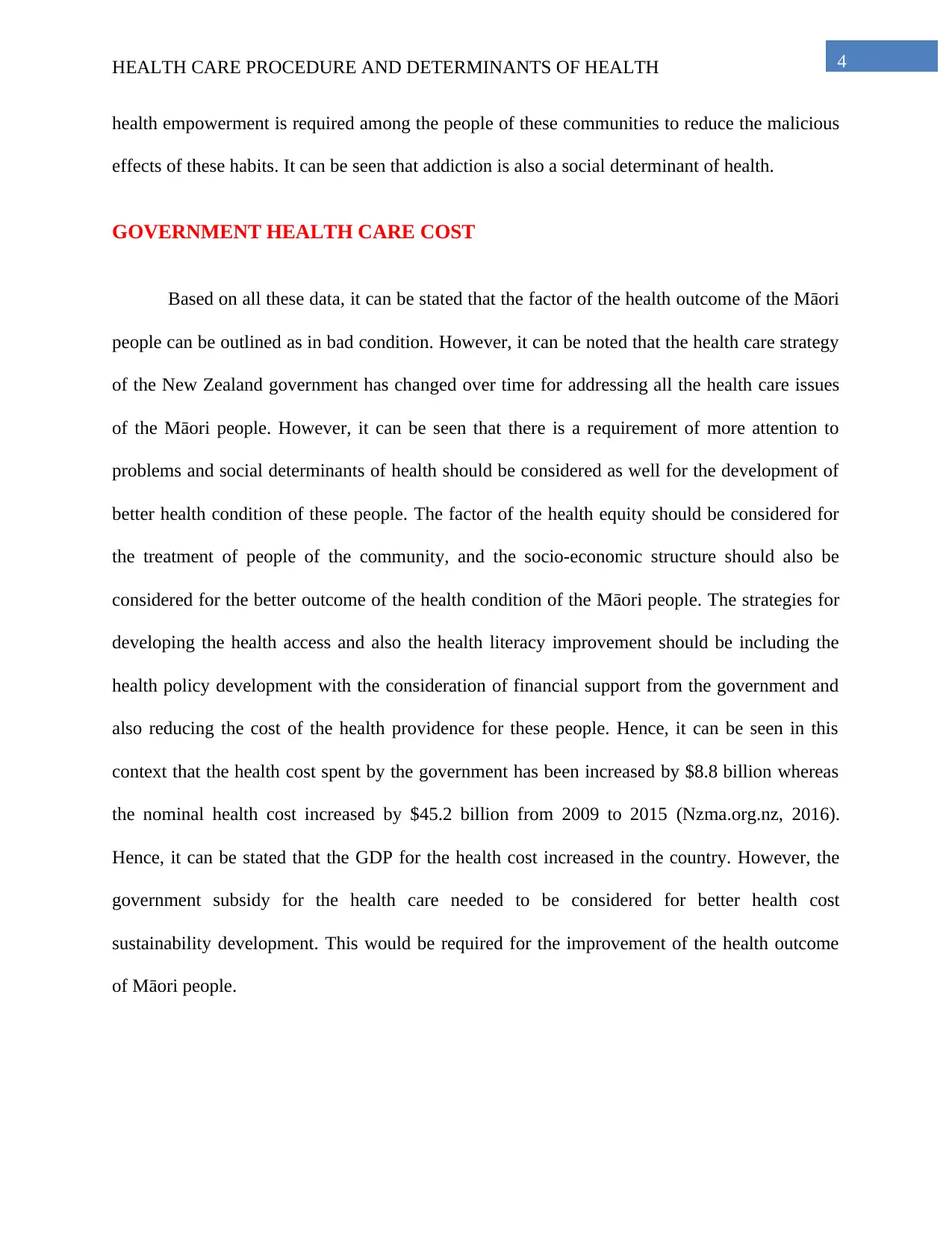
4HEALTH CARE PROCEDURE AND DETERMINANTS OF HEALTH
health empowerment is required among the people of these communities to reduce the malicious
effects of these habits. It can be seen that addiction is also a social determinant of health.
GOVERNMENT HEALTH CARE COST
Based on all these data, it can be stated that the factor of the health outcome of the Māori
people can be outlined as in bad condition. However, it can be noted that the health care strategy
of the New Zealand government has changed over time for addressing all the health care issues
of the Māori people. However, it can be seen that there is a requirement of more attention to
problems and social determinants of health should be considered as well for the development of
better health condition of these people. The factor of the health equity should be considered for
the treatment of people of the community, and the socio-economic structure should also be
considered for the better outcome of the health condition of the Māori people. The strategies for
developing the health access and also the health literacy improvement should be including the
health policy development with the consideration of financial support from the government and
also reducing the cost of the health providence for these people. Hence, it can be seen in this
context that the health cost spent by the government has been increased by $8.8 billion whereas
the nominal health cost increased by $45.2 billion from 2009 to 2015 (Nzma.org.nz, 2016).
Hence, it can be stated that the GDP for the health cost increased in the country. However, the
government subsidy for the health care needed to be considered for better health cost
sustainability development. This would be required for the improvement of the health outcome
of Māori people.
health empowerment is required among the people of these communities to reduce the malicious
effects of these habits. It can be seen that addiction is also a social determinant of health.
GOVERNMENT HEALTH CARE COST
Based on all these data, it can be stated that the factor of the health outcome of the Māori
people can be outlined as in bad condition. However, it can be noted that the health care strategy
of the New Zealand government has changed over time for addressing all the health care issues
of the Māori people. However, it can be seen that there is a requirement of more attention to
problems and social determinants of health should be considered as well for the development of
better health condition of these people. The factor of the health equity should be considered for
the treatment of people of the community, and the socio-economic structure should also be
considered for the better outcome of the health condition of the Māori people. The strategies for
developing the health access and also the health literacy improvement should be including the
health policy development with the consideration of financial support from the government and
also reducing the cost of the health providence for these people. Hence, it can be seen in this
context that the health cost spent by the government has been increased by $8.8 billion whereas
the nominal health cost increased by $45.2 billion from 2009 to 2015 (Nzma.org.nz, 2016).
Hence, it can be stated that the GDP for the health cost increased in the country. However, the
government subsidy for the health care needed to be considered for better health cost
sustainability development. This would be required for the improvement of the health outcome
of Māori people.
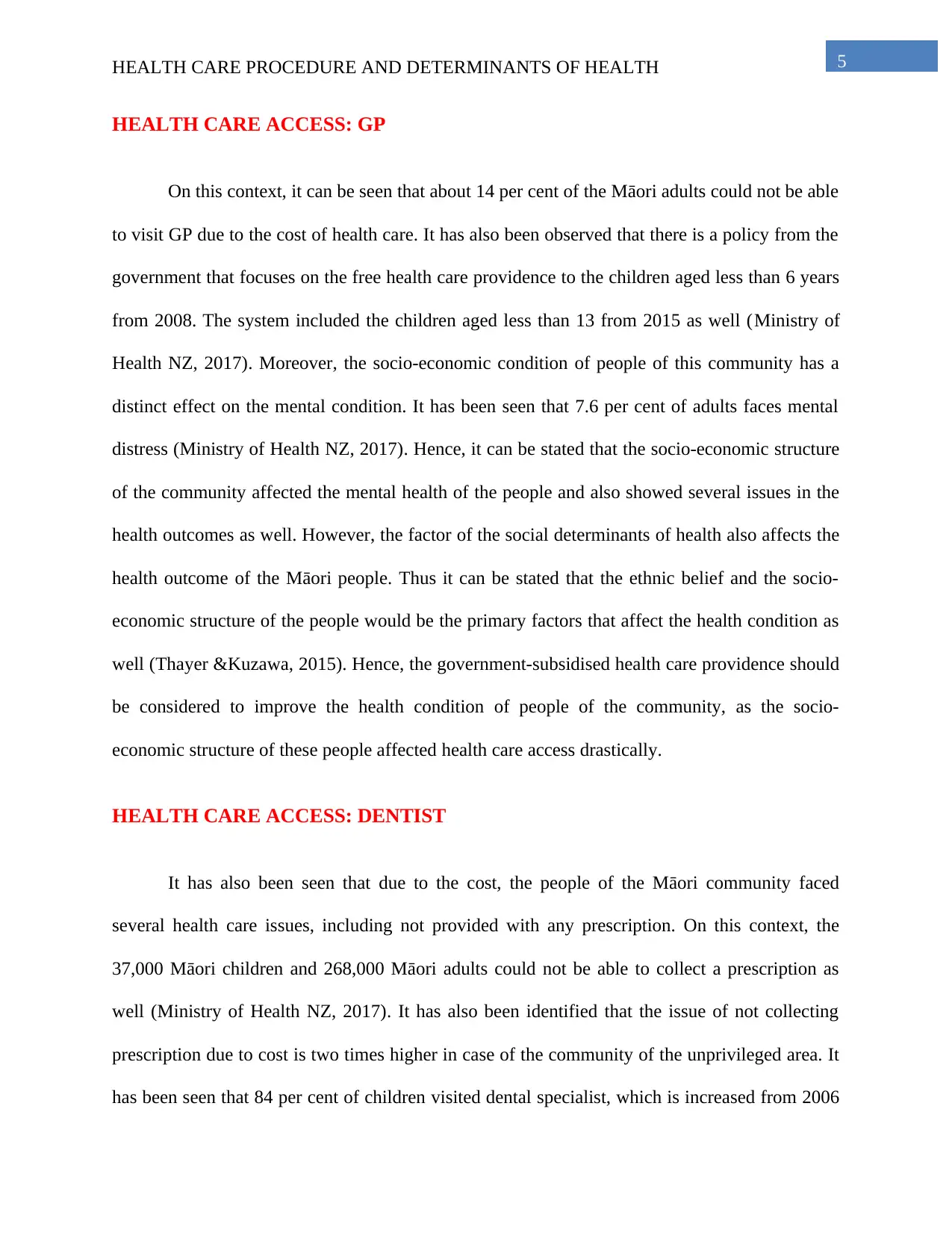
5HEALTH CARE PROCEDURE AND DETERMINANTS OF HEALTH
HEALTH CARE ACCESS: GP
On this context, it can be seen that about 14 per cent of the Māori adults could not be able
to visit GP due to the cost of health care. It has also been observed that there is a policy from the
government that focuses on the free health care providence to the children aged less than 6 years
from 2008. The system included the children aged less than 13 from 2015 as well (Ministry of
Health NZ, 2017). Moreover, the socio-economic condition of people of this community has a
distinct effect on the mental condition. It has been seen that 7.6 per cent of adults faces mental
distress (Ministry of Health NZ, 2017). Hence, it can be stated that the socio-economic structure
of the community affected the mental health of the people and also showed several issues in the
health outcomes as well. However, the factor of the social determinants of health also affects the
health outcome of the Māori people. Thus it can be stated that the ethnic belief and the socio-
economic structure of the people would be the primary factors that affect the health condition as
well (Thayer &Kuzawa, 2015). Hence, the government-subsidised health care providence should
be considered to improve the health condition of people of the community, as the socio-
economic structure of these people affected health care access drastically.
HEALTH CARE ACCESS: DENTIST
It has also been seen that due to the cost, the people of the Māori community faced
several health care issues, including not provided with any prescription. On this context, the
37,000 Māori children and 268,000 Māori adults could not be able to collect a prescription as
well (Ministry of Health NZ, 2017). It has also been identified that the issue of not collecting
prescription due to cost is two times higher in case of the community of the unprivileged area. It
has been seen that 84 per cent of children visited dental specialist, which is increased from 2006
HEALTH CARE ACCESS: GP
On this context, it can be seen that about 14 per cent of the Māori adults could not be able
to visit GP due to the cost of health care. It has also been observed that there is a policy from the
government that focuses on the free health care providence to the children aged less than 6 years
from 2008. The system included the children aged less than 13 from 2015 as well (Ministry of
Health NZ, 2017). Moreover, the socio-economic condition of people of this community has a
distinct effect on the mental condition. It has been seen that 7.6 per cent of adults faces mental
distress (Ministry of Health NZ, 2017). Hence, it can be stated that the socio-economic structure
of the community affected the mental health of the people and also showed several issues in the
health outcomes as well. However, the factor of the social determinants of health also affects the
health outcome of the Māori people. Thus it can be stated that the ethnic belief and the socio-
economic structure of the people would be the primary factors that affect the health condition as
well (Thayer &Kuzawa, 2015). Hence, the government-subsidised health care providence should
be considered to improve the health condition of people of the community, as the socio-
economic structure of these people affected health care access drastically.
HEALTH CARE ACCESS: DENTIST
It has also been seen that due to the cost, the people of the Māori community faced
several health care issues, including not provided with any prescription. On this context, the
37,000 Māori children and 268,000 Māori adults could not be able to collect a prescription as
well (Ministry of Health NZ, 2017). It has also been identified that the issue of not collecting
prescription due to cost is two times higher in case of the community of the unprivileged area. It
has been seen that 84 per cent of children visited dental specialist, which is increased from 2006
⊘ This is a preview!⊘
Do you want full access?
Subscribe today to unlock all pages.

Trusted by 1+ million students worldwide
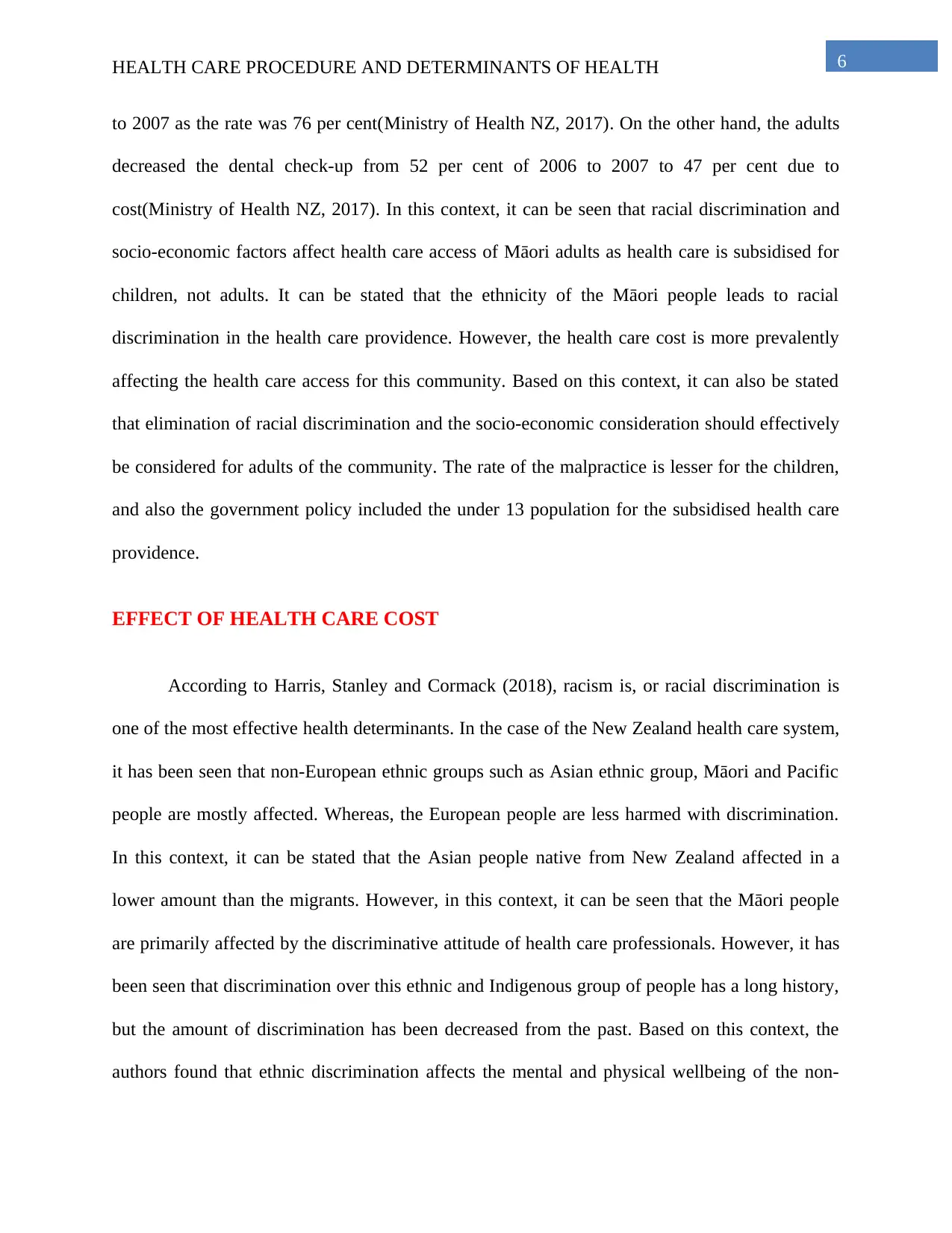
6HEALTH CARE PROCEDURE AND DETERMINANTS OF HEALTH
to 2007 as the rate was 76 per cent(Ministry of Health NZ, 2017). On the other hand, the adults
decreased the dental check-up from 52 per cent of 2006 to 2007 to 47 per cent due to
cost(Ministry of Health NZ, 2017). In this context, it can be seen that racial discrimination and
socio-economic factors affect health care access of Māori adults as health care is subsidised for
children, not adults. It can be stated that the ethnicity of the Māori people leads to racial
discrimination in the health care providence. However, the health care cost is more prevalently
affecting the health care access for this community. Based on this context, it can also be stated
that elimination of racial discrimination and the socio-economic consideration should effectively
be considered for adults of the community. The rate of the malpractice is lesser for the children,
and also the government policy included the under 13 population for the subsidised health care
providence.
EFFECT OF HEALTH CARE COST
According to Harris, Stanley and Cormack (2018), racism is, or racial discrimination is
one of the most effective health determinants. In the case of the New Zealand health care system,
it has been seen that non-European ethnic groups such as Asian ethnic group, Māori and Pacific
people are mostly affected. Whereas, the European people are less harmed with discrimination.
In this context, it can be stated that the Asian people native from New Zealand affected in a
lower amount than the migrants. However, in this context, it can be seen that the Māori people
are primarily affected by the discriminative attitude of health care professionals. However, it has
been seen that discrimination over this ethnic and Indigenous group of people has a long history,
but the amount of discrimination has been decreased from the past. Based on this context, the
authors found that ethnic discrimination affects the mental and physical wellbeing of the non-
to 2007 as the rate was 76 per cent(Ministry of Health NZ, 2017). On the other hand, the adults
decreased the dental check-up from 52 per cent of 2006 to 2007 to 47 per cent due to
cost(Ministry of Health NZ, 2017). In this context, it can be seen that racial discrimination and
socio-economic factors affect health care access of Māori adults as health care is subsidised for
children, not adults. It can be stated that the ethnicity of the Māori people leads to racial
discrimination in the health care providence. However, the health care cost is more prevalently
affecting the health care access for this community. Based on this context, it can also be stated
that elimination of racial discrimination and the socio-economic consideration should effectively
be considered for adults of the community. The rate of the malpractice is lesser for the children,
and also the government policy included the under 13 population for the subsidised health care
providence.
EFFECT OF HEALTH CARE COST
According to Harris, Stanley and Cormack (2018), racism is, or racial discrimination is
one of the most effective health determinants. In the case of the New Zealand health care system,
it has been seen that non-European ethnic groups such as Asian ethnic group, Māori and Pacific
people are mostly affected. Whereas, the European people are less harmed with discrimination.
In this context, it can be stated that the Asian people native from New Zealand affected in a
lower amount than the migrants. However, in this context, it can be seen that the Māori people
are primarily affected by the discriminative attitude of health care professionals. However, it has
been seen that discrimination over this ethnic and Indigenous group of people has a long history,
but the amount of discrimination has been decreased from the past. Based on this context, the
authors found that ethnic discrimination affects the mental and physical wellbeing of the non-
Paraphrase This Document
Need a fresh take? Get an instant paraphrase of this document with our AI Paraphraser
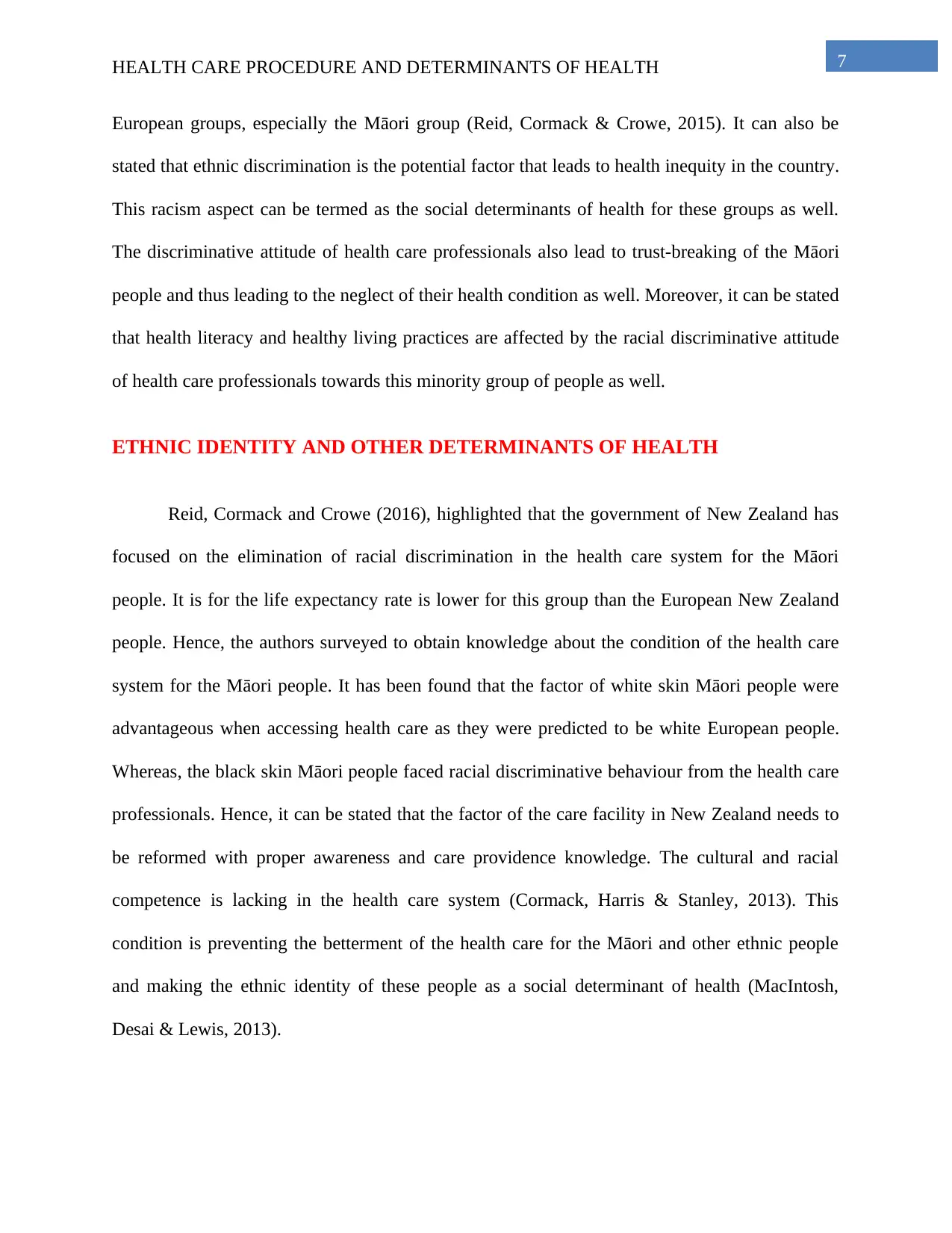
7HEALTH CARE PROCEDURE AND DETERMINANTS OF HEALTH
European groups, especially the Māori group (Reid, Cormack & Crowe, 2015). It can also be
stated that ethnic discrimination is the potential factor that leads to health inequity in the country.
This racism aspect can be termed as the social determinants of health for these groups as well.
The discriminative attitude of health care professionals also lead to trust-breaking of the Māori
people and thus leading to the neglect of their health condition as well. Moreover, it can be stated
that health literacy and healthy living practices are affected by the racial discriminative attitude
of health care professionals towards this minority group of people as well.
ETHNIC IDENTITY AND OTHER DETERMINANTS OF HEALTH
Reid, Cormack and Crowe (2016), highlighted that the government of New Zealand has
focused on the elimination of racial discrimination in the health care system for the Māori
people. It is for the life expectancy rate is lower for this group than the European New Zealand
people. Hence, the authors surveyed to obtain knowledge about the condition of the health care
system for the Māori people. It has been found that the factor of white skin Māori people were
advantageous when accessing health care as they were predicted to be white European people.
Whereas, the black skin Māori people faced racial discriminative behaviour from the health care
professionals. Hence, it can be stated that the factor of the care facility in New Zealand needs to
be reformed with proper awareness and care providence knowledge. The cultural and racial
competence is lacking in the health care system (Cormack, Harris & Stanley, 2013). This
condition is preventing the betterment of the health care for the Māori and other ethnic people
and making the ethnic identity of these people as a social determinant of health (MacIntosh,
Desai & Lewis, 2013).
European groups, especially the Māori group (Reid, Cormack & Crowe, 2015). It can also be
stated that ethnic discrimination is the potential factor that leads to health inequity in the country.
This racism aspect can be termed as the social determinants of health for these groups as well.
The discriminative attitude of health care professionals also lead to trust-breaking of the Māori
people and thus leading to the neglect of their health condition as well. Moreover, it can be stated
that health literacy and healthy living practices are affected by the racial discriminative attitude
of health care professionals towards this minority group of people as well.
ETHNIC IDENTITY AND OTHER DETERMINANTS OF HEALTH
Reid, Cormack and Crowe (2016), highlighted that the government of New Zealand has
focused on the elimination of racial discrimination in the health care system for the Māori
people. It is for the life expectancy rate is lower for this group than the European New Zealand
people. Hence, the authors surveyed to obtain knowledge about the condition of the health care
system for the Māori people. It has been found that the factor of white skin Māori people were
advantageous when accessing health care as they were predicted to be white European people.
Whereas, the black skin Māori people faced racial discriminative behaviour from the health care
professionals. Hence, it can be stated that the factor of the care facility in New Zealand needs to
be reformed with proper awareness and care providence knowledge. The cultural and racial
competence is lacking in the health care system (Cormack, Harris & Stanley, 2013). This
condition is preventing the betterment of the health care for the Māori and other ethnic people
and making the ethnic identity of these people as a social determinant of health (MacIntosh,
Desai & Lewis, 2013).
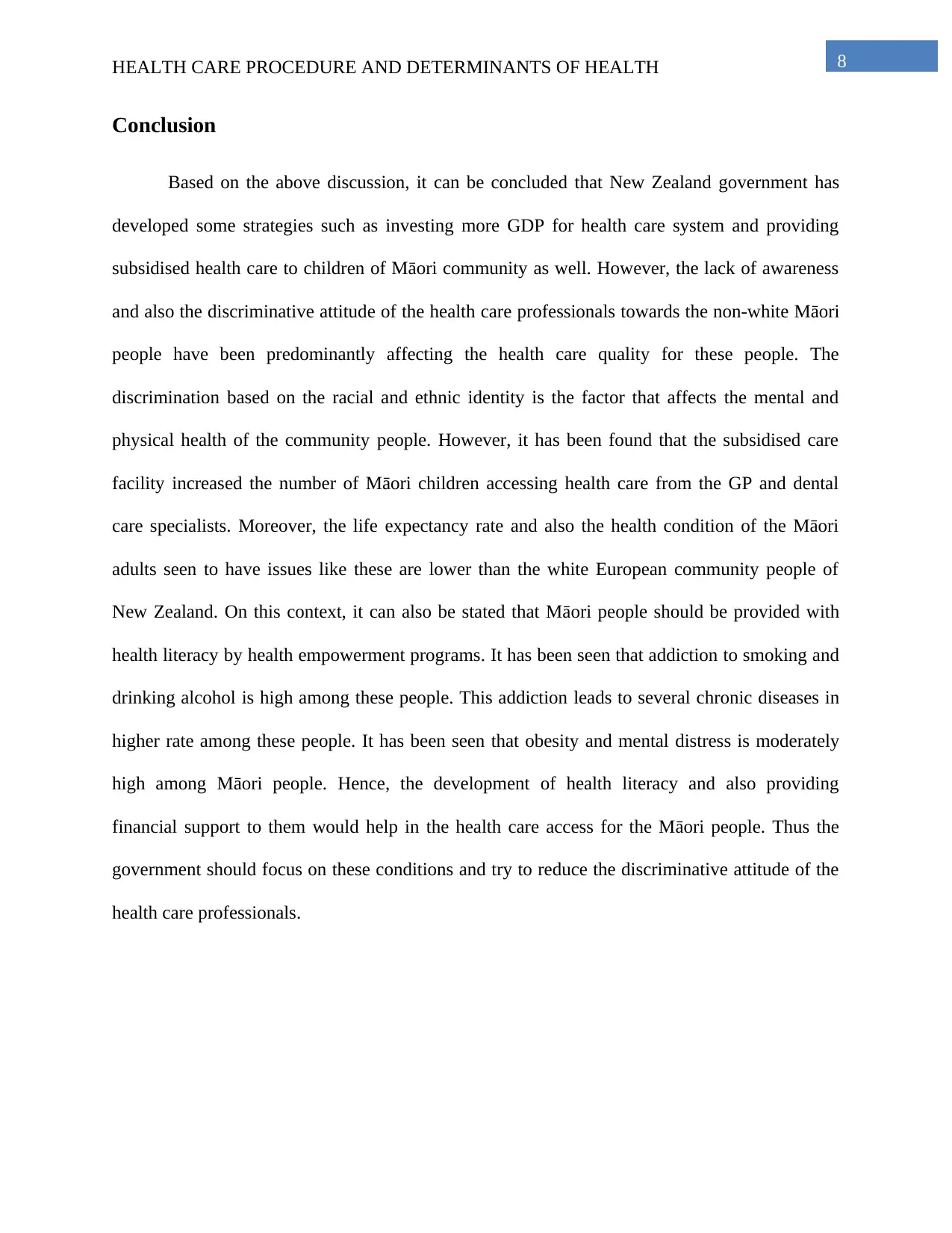
8HEALTH CARE PROCEDURE AND DETERMINANTS OF HEALTH
Conclusion
Based on the above discussion, it can be concluded that New Zealand government has
developed some strategies such as investing more GDP for health care system and providing
subsidised health care to children of Māori community as well. However, the lack of awareness
and also the discriminative attitude of the health care professionals towards the non-white Māori
people have been predominantly affecting the health care quality for these people. The
discrimination based on the racial and ethnic identity is the factor that affects the mental and
physical health of the community people. However, it has been found that the subsidised care
facility increased the number of Māori children accessing health care from the GP and dental
care specialists. Moreover, the life expectancy rate and also the health condition of the Māori
adults seen to have issues like these are lower than the white European community people of
New Zealand. On this context, it can also be stated that Māori people should be provided with
health literacy by health empowerment programs. It has been seen that addiction to smoking and
drinking alcohol is high among these people. This addiction leads to several chronic diseases in
higher rate among these people. It has been seen that obesity and mental distress is moderately
high among Māori people. Hence, the development of health literacy and also providing
financial support to them would help in the health care access for the Māori people. Thus the
government should focus on these conditions and try to reduce the discriminative attitude of the
health care professionals.
Conclusion
Based on the above discussion, it can be concluded that New Zealand government has
developed some strategies such as investing more GDP for health care system and providing
subsidised health care to children of Māori community as well. However, the lack of awareness
and also the discriminative attitude of the health care professionals towards the non-white Māori
people have been predominantly affecting the health care quality for these people. The
discrimination based on the racial and ethnic identity is the factor that affects the mental and
physical health of the community people. However, it has been found that the subsidised care
facility increased the number of Māori children accessing health care from the GP and dental
care specialists. Moreover, the life expectancy rate and also the health condition of the Māori
adults seen to have issues like these are lower than the white European community people of
New Zealand. On this context, it can also be stated that Māori people should be provided with
health literacy by health empowerment programs. It has been seen that addiction to smoking and
drinking alcohol is high among these people. This addiction leads to several chronic diseases in
higher rate among these people. It has been seen that obesity and mental distress is moderately
high among Māori people. Hence, the development of health literacy and also providing
financial support to them would help in the health care access for the Māori people. Thus the
government should focus on these conditions and try to reduce the discriminative attitude of the
health care professionals.
⊘ This is a preview!⊘
Do you want full access?
Subscribe today to unlock all pages.

Trusted by 1+ million students worldwide
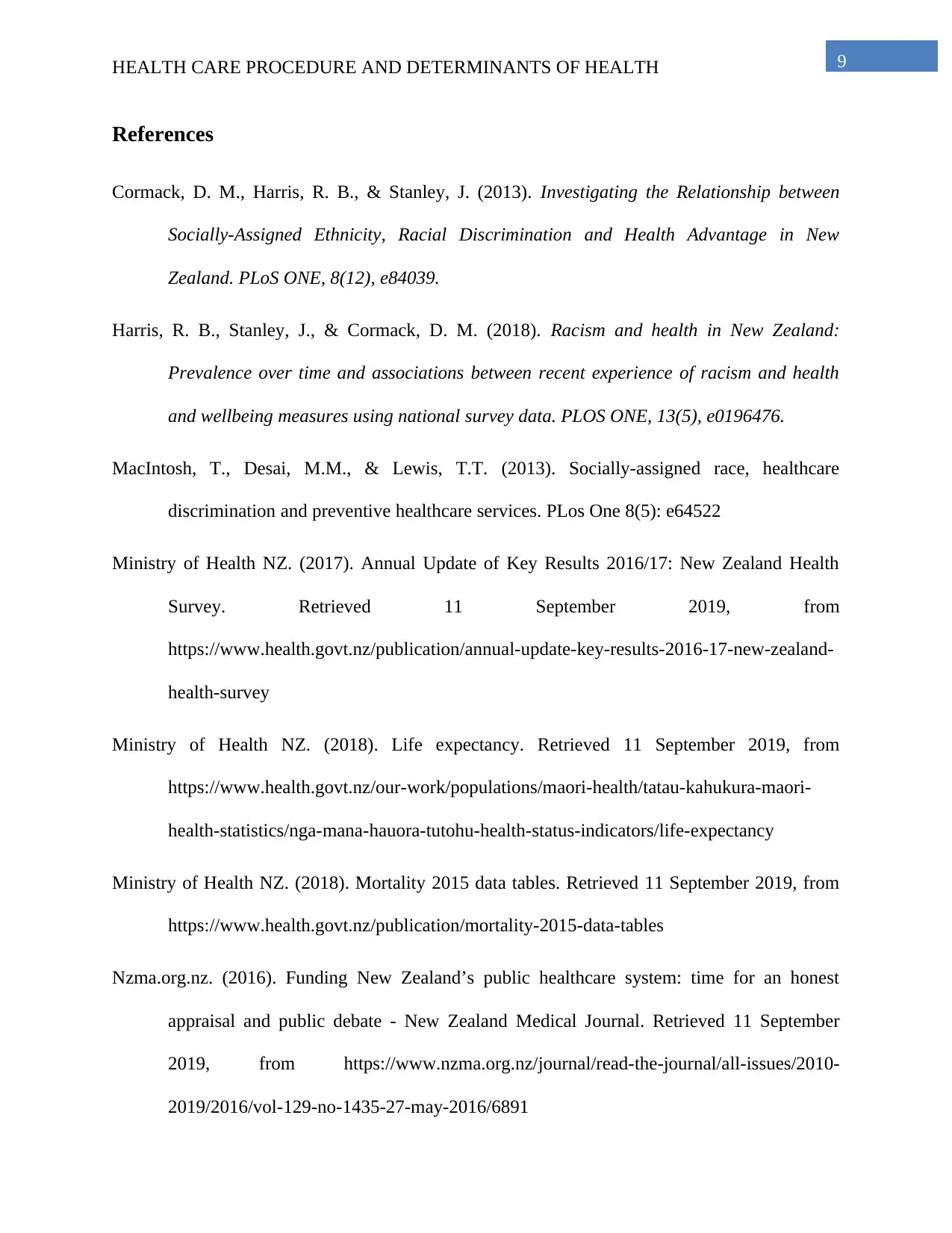
9HEALTH CARE PROCEDURE AND DETERMINANTS OF HEALTH
References
Cormack, D. M., Harris, R. B., & Stanley, J. (2013). Investigating the Relationship between
Socially-Assigned Ethnicity, Racial Discrimination and Health Advantage in New
Zealand. PLoS ONE, 8(12), e84039.
Harris, R. B., Stanley, J., & Cormack, D. M. (2018). Racism and health in New Zealand:
Prevalence over time and associations between recent experience of racism and health
and wellbeing measures using national survey data. PLOS ONE, 13(5), e0196476.
MacIntosh, T., Desai, M.M., & Lewis, T.T. (2013). Socially-assigned race, healthcare
discrimination and preventive healthcare services. PLos One 8(5): e64522
Ministry of Health NZ. (2017). Annual Update of Key Results 2016/17: New Zealand Health
Survey. Retrieved 11 September 2019, from
https://www.health.govt.nz/publication/annual-update-key-results-2016-17-new-zealand-
health-survey
Ministry of Health NZ. (2018). Life expectancy. Retrieved 11 September 2019, from
https://www.health.govt.nz/our-work/populations/maori-health/tatau-kahukura-maori-
health-statistics/nga-mana-hauora-tutohu-health-status-indicators/life-expectancy
Ministry of Health NZ. (2018). Mortality 2015 data tables. Retrieved 11 September 2019, from
https://www.health.govt.nz/publication/mortality-2015-data-tables
Nzma.org.nz. (2016). Funding New Zealand’s public healthcare system: time for an honest
appraisal and public debate - New Zealand Medical Journal. Retrieved 11 September
2019, from https://www.nzma.org.nz/journal/read-the-journal/all-issues/2010-
2019/2016/vol-129-no-1435-27-may-2016/6891
References
Cormack, D. M., Harris, R. B., & Stanley, J. (2013). Investigating the Relationship between
Socially-Assigned Ethnicity, Racial Discrimination and Health Advantage in New
Zealand. PLoS ONE, 8(12), e84039.
Harris, R. B., Stanley, J., & Cormack, D. M. (2018). Racism and health in New Zealand:
Prevalence over time and associations between recent experience of racism and health
and wellbeing measures using national survey data. PLOS ONE, 13(5), e0196476.
MacIntosh, T., Desai, M.M., & Lewis, T.T. (2013). Socially-assigned race, healthcare
discrimination and preventive healthcare services. PLos One 8(5): e64522
Ministry of Health NZ. (2017). Annual Update of Key Results 2016/17: New Zealand Health
Survey. Retrieved 11 September 2019, from
https://www.health.govt.nz/publication/annual-update-key-results-2016-17-new-zealand-
health-survey
Ministry of Health NZ. (2018). Life expectancy. Retrieved 11 September 2019, from
https://www.health.govt.nz/our-work/populations/maori-health/tatau-kahukura-maori-
health-statistics/nga-mana-hauora-tutohu-health-status-indicators/life-expectancy
Ministry of Health NZ. (2018). Mortality 2015 data tables. Retrieved 11 September 2019, from
https://www.health.govt.nz/publication/mortality-2015-data-tables
Nzma.org.nz. (2016). Funding New Zealand’s public healthcare system: time for an honest
appraisal and public debate - New Zealand Medical Journal. Retrieved 11 September
2019, from https://www.nzma.org.nz/journal/read-the-journal/all-issues/2010-
2019/2016/vol-129-no-1435-27-may-2016/6891
Paraphrase This Document
Need a fresh take? Get an instant paraphrase of this document with our AI Paraphraser
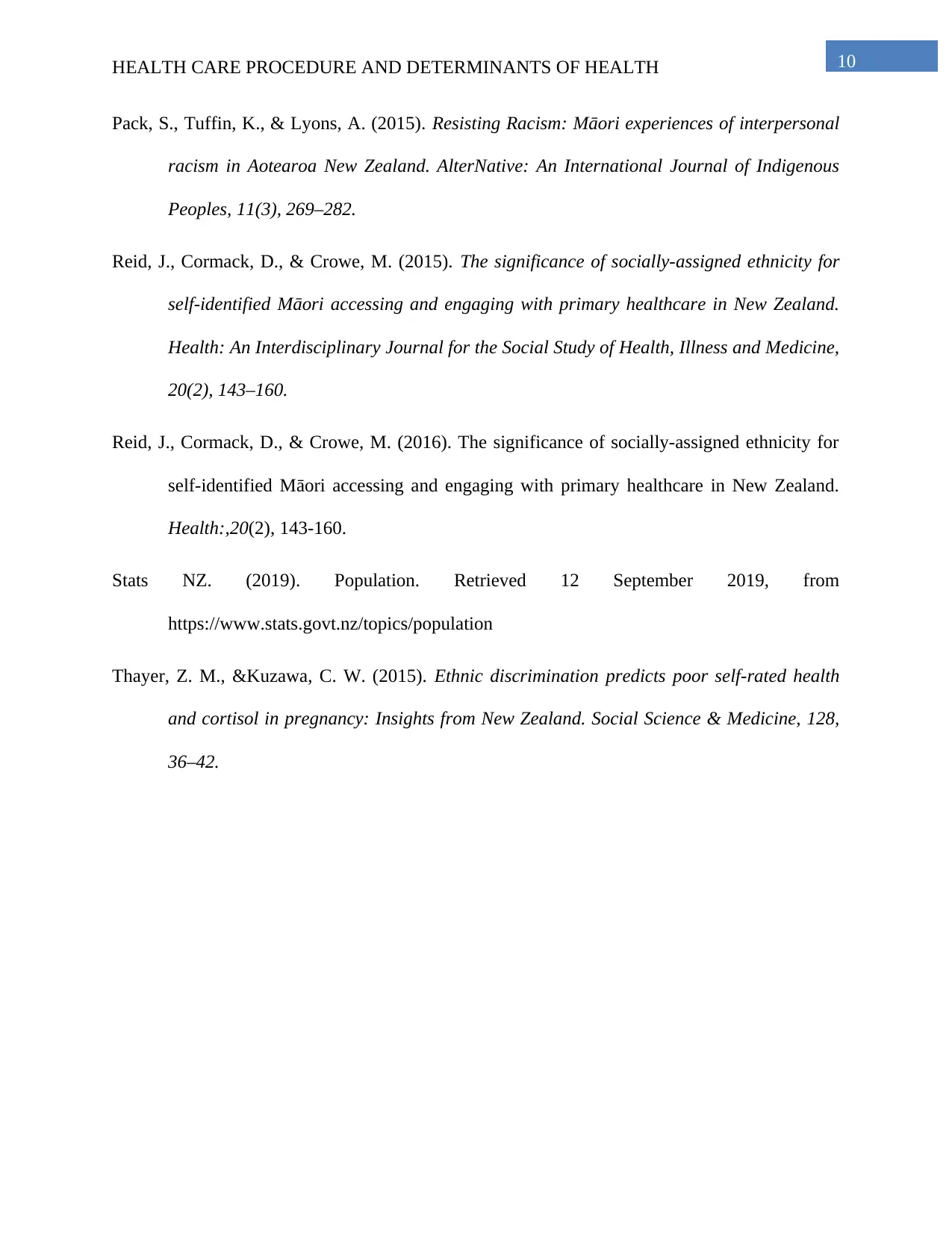
10HEALTH CARE PROCEDURE AND DETERMINANTS OF HEALTH
Pack, S., Tuffin, K., & Lyons, A. (2015). Resisting Racism: Māori experiences of interpersonal
racism in Aotearoa New Zealand. AlterNative: An International Journal of Indigenous
Peoples, 11(3), 269–282.
Reid, J., Cormack, D., & Crowe, M. (2015). The significance of socially-assigned ethnicity for
self-identified Māori accessing and engaging with primary healthcare in New Zealand.
Health: An Interdisciplinary Journal for the Social Study of Health, Illness and Medicine,
20(2), 143–160.
Reid, J., Cormack, D., & Crowe, M. (2016). The significance of socially-assigned ethnicity for
self-identified Māori accessing and engaging with primary healthcare in New Zealand.
Health:,20(2), 143-160.
Stats NZ. (2019). Population. Retrieved 12 September 2019, from
https://www.stats.govt.nz/topics/population
Thayer, Z. M., &Kuzawa, C. W. (2015). Ethnic discrimination predicts poor self-rated health
and cortisol in pregnancy: Insights from New Zealand. Social Science & Medicine, 128,
36–42.
Pack, S., Tuffin, K., & Lyons, A. (2015). Resisting Racism: Māori experiences of interpersonal
racism in Aotearoa New Zealand. AlterNative: An International Journal of Indigenous
Peoples, 11(3), 269–282.
Reid, J., Cormack, D., & Crowe, M. (2015). The significance of socially-assigned ethnicity for
self-identified Māori accessing and engaging with primary healthcare in New Zealand.
Health: An Interdisciplinary Journal for the Social Study of Health, Illness and Medicine,
20(2), 143–160.
Reid, J., Cormack, D., & Crowe, M. (2016). The significance of socially-assigned ethnicity for
self-identified Māori accessing and engaging with primary healthcare in New Zealand.
Health:,20(2), 143-160.
Stats NZ. (2019). Population. Retrieved 12 September 2019, from
https://www.stats.govt.nz/topics/population
Thayer, Z. M., &Kuzawa, C. W. (2015). Ethnic discrimination predicts poor self-rated health
and cortisol in pregnancy: Insights from New Zealand. Social Science & Medicine, 128,
36–42.
1 out of 11
Related Documents
Your All-in-One AI-Powered Toolkit for Academic Success.
+13062052269
info@desklib.com
Available 24*7 on WhatsApp / Email
![[object Object]](/_next/static/media/star-bottom.7253800d.svg)
Unlock your academic potential
Copyright © 2020–2025 A2Z Services. All Rights Reserved. Developed and managed by ZUCOL.





